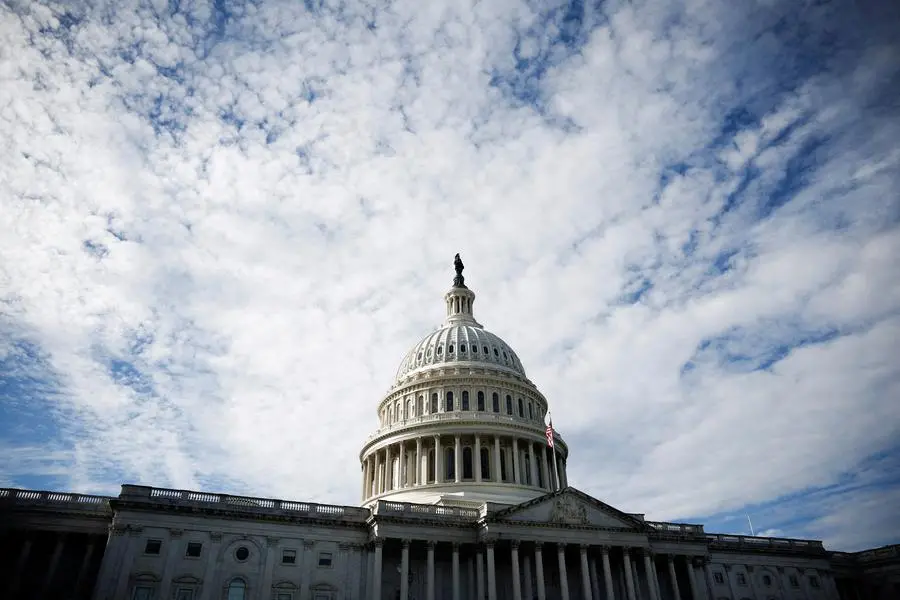PHOTO
LONDON - Relief following the tariff war de-escalation looks set to be quickly replaced by government budget tensions. Alarms are ringing loudly as the U.S. hits an historic debt metric even as the administration is seeking to extend tax cuts.
Republicans in the U.S. House of Representatives, navigating a narrow majority, this week kicked off a public debate on President Donald Trump's tax cut and budget legislation.
The plan aims to extend tax cuts passed during Trump's first term. Congress' bipartisan Joint Tax Committee estimates these could cost $3.72 trillion over the next decade on top of the nation's already record $36.2 trillion debt.
Plans to boost spending on border security and national defense add to the pressure, not least because hoped-for savings from the so-called Department of Government Efficiency (DOGE) drive appear to be falling short. The anticipated revenue from import tariffs is also still up in the air as bilateral talks continue to unfold.
Reports have swirled over the past week that the administration could make cuts in everything from housing, education and medical research to the State Department in order to hit a proposed spending reduction target of $163 billion next year.
Other reports have even suggested Trump had signaled a willingness to bump up the country's top tax rate to almost 40%, while some claimed DOGE is looking at military spending cuts.
On the "millionaire's tax", Trump subsequently clarified on his social media platform: "Republicans should probably not do it, but I'm OK if they do!!!"
Meanwhile, the fiscal package looks to raise the debt limit by $4 trillion, and Treasury Secretary Scott Bessent has already urged lawmakers to act by mid-July to avoid creating any default cliff-hangers that could add more tension to the Treasury market and financial markets more broadly.
Without an agreement on extending the debt ceiling, the so-called "X date", or when the government runs out of money to pay its bills, is set for August.
TENSE TREASURIES
After a jarring start to the year, Treasury markets are still on edge. A correlated selloff with stocks following the tariff shock early last month jangled nerves, and expectations of recession-led rate cuts were unwound over the last week on news of the trade war detente.
With the Federal Reserve unwilling to ease credit policy again until it can assess the tariff-related inflation picture, there's currently little comfort coming from the central bank.
Ten-year Treasury yields are stalking their highest levels in three months at about 4.47%, with the perceived risk of holding long-term debt reflected in the so-called "term premium" hovering at 10-year highs around 70 basis points.
The Congressional Budget Office's long-term debt outlook in March assumed a 2025 10-year Treasury yield of 4.1%, but it's averaged 4.4% for the year to date and is going in the wrong direction.
Even given the CBO's benign assumptions, it still sees federal debt topping 100% of gross domestic product this year for the first time since World War Two and then rising to almost 120% in 10 years and 156% by 2055.
And the mood on the fiscal picture seems to have soured despite some post-election hopes of more serious attempts to roll back the deficits.
Currency fund manager Stephen Jen and Joana Freire at Eurizon SLJ outlined on Tuesday their disappointment at how both the spending math and the political calculations in Congress were panning out.
"Long-term US Treasury yields being stubbornly elevated suggests that investors no longer believe in the U.S. ability to bend the fiscal deficit curve. We share this concern."
Jen and Freire reckon the basic numbers don't look likely to bridge the gap between a budget of $7 trillion and revenues of about $5 trillion. Even with their estimates of about $500 billion of DOGE cost cuts and about $300 billion from tariffs, the deficit still sits near $1.2 trillion.
Morgan Stanley expects the 2026 U.S. fiscal deficit to rise to 7.1% of GDP from 6.7% this year, an increase of about $310 billion year on year.
This brings to mind an alarming statistic often quoted by conservative British historian Niall Ferguson.
Citing an observation first made by 18th-century economist Adam Ferguson, the Stanford historian points out that countries or empires of the past 500 years - such as the British, Spanish and Ottoman empires - have started to decline when their debt service bill exceeded military spending. And America hit that point last year.
There are numerous caveats attached to this - not least that China also appears to have hit the same metric and also that there was a brief U.S. flirtation with it in the late 1990s.
But for an administration keen on making America great again, that somewhat wonky fiscal milestone may resonate.
The opinions expressed here are those of the author, a columnist for Reuters
(By Mike Dolan; Editing by Lisa Shumaker)
Reuters





















